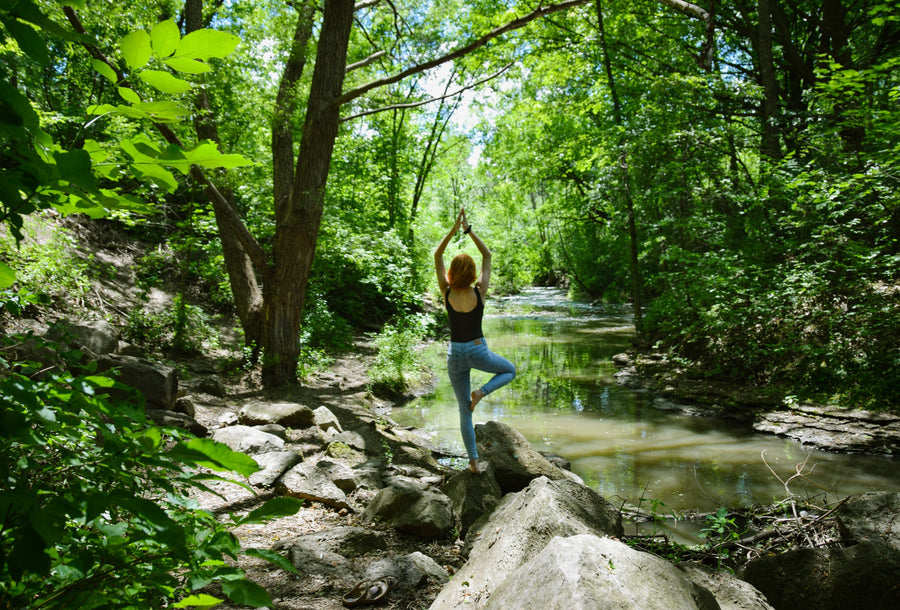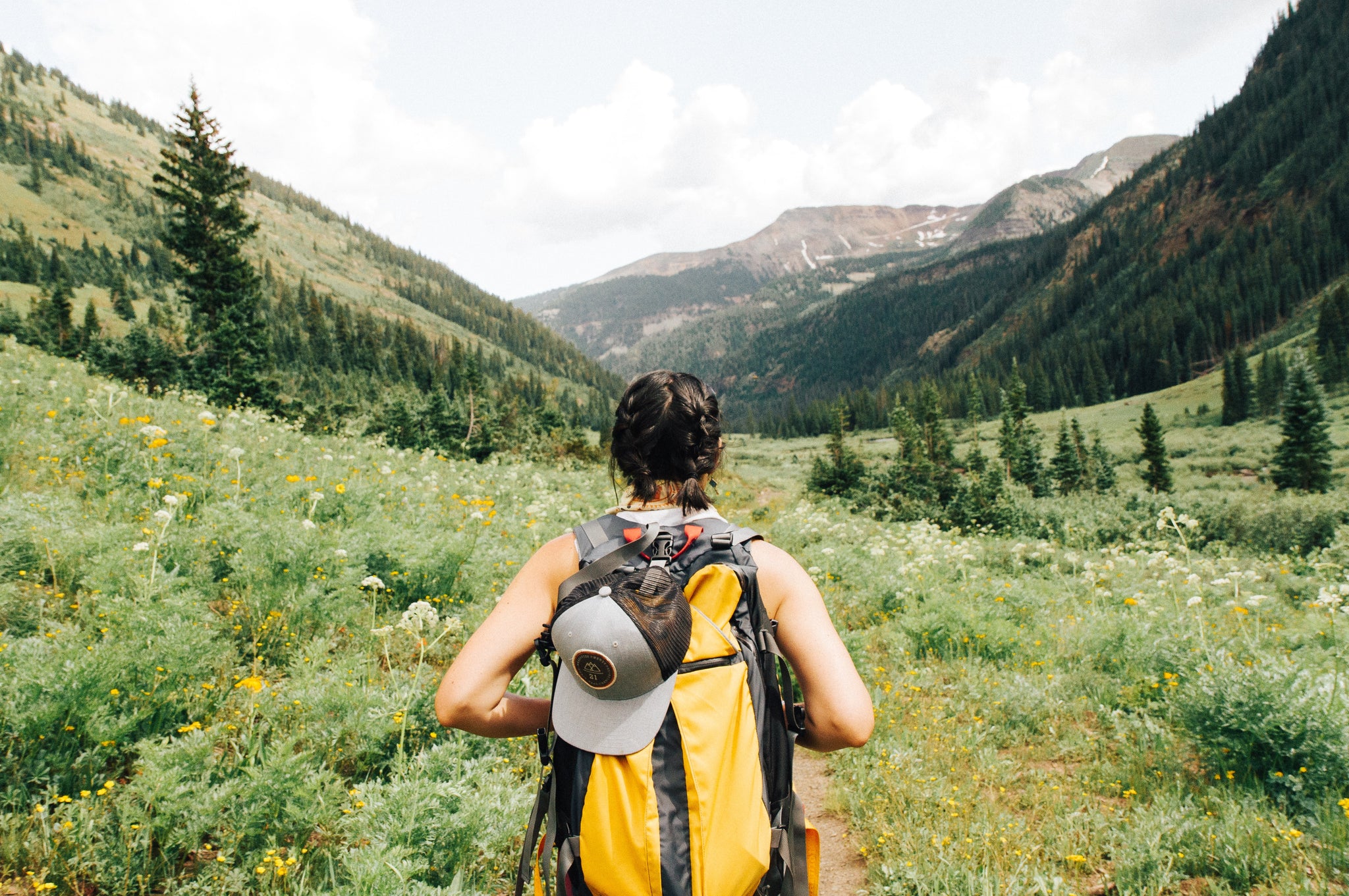Into the wild: 8 ways exercising in nature brings health benefits

Summer is in full swing, and with it, our appetite for being out in the wild and reconnecting with nature.
Over the past 18 months, we’ve done endless YouTube workouts, used canned beans as makeshift weights and unfurled yoga mats across living room floors. With the sun shining and some semblance of normality resuming, it feels like the time has finally come to get out there and get active. And whether it’s a lower chance of developing depression or boosted energy levels, research shows that exercising outdoors can bring added health benefits.
Here’s 8 ways working out in nature can enhance the positive effects of exercise:
1. It calms the nervous system, lowers blood pressure and reduces anxiety
According to the Forestry Research Institute in Japan,[1] just being outside can lower our levels of the stress hormone cortisol by as much as 15%. Add the endorphin-increasing act of moving into the mix, and the benefits of being in nature are amplified.
Jo Barton from the University of Essex told The Guardian she believes that working out in the fresh air could be “life changing”.
"Exercising in nature lifts your mood and boosts your self-esteem,” she says. "Research implies this is true regardless of the weather conditions, where you are, and how long you exercise outside. Even a five-minute walk outside to escape your work can re-energise you and restore your mental fatigue.”
The mindful aspect of moving in nature is also significant. Exercising outdoors allows us to absorb so much more of our environment – the sound of waves lapping the shore, the feel of a breeze on our skin, the colour of the leaves on the branches above – which we can easily miss when we’re racing from one thing to the next. By externalising our attention, we can calm our nervous system and fully relax.
“It’s amazing watching the change in people from the start of a beach yoga class to the end,” Cornwall beach yoga instructor Alicia Ray said in a recent interview. “The walk back across the dunes is calmer, more zen – I notice that people pause to take in the scenery, listen to the sounds.”
And, according to a study[2] by the University of Exeter, exercising in the fresh air might also help lower our blood pressure more effectively, with post-workout blood pressure returning to normal faster amongst those who exercised in rural settings compared to urban scenery.

2. It returns our bodies to their primal setting
We might think of ourselves as sophisticated go-getters, prospering in a glossy modern world, but the fact remains: if you’re a human being, you’re designed for life in the wild.
Over millions of years, humans have evolved to thrive in natural settings, with built environments barely featuring on the long timescale of our existence on Earth.
Erwan Le Corre, the founder of MovNat, an outdoor fitness system that prioritises natural movement over burning calories, told the Evening Standard that he believes our sterilised modern lifestyles are akin to a “human zoo”. He told the paper: “We have become divorced from nature, trapped in colourless boxes. We have lost our adaptability, and it’s threatening our health and longevity.”
Le Corre believes that “being fit isn’t about being able to lift a steel bar or finish an Ironman. It’s about rediscovering our biological nature and releasing the wild human animal inside.”
As well as tapping into our primal instincts, exercising outdoors allows our bodies to move as they always have, amongst familiar natural terrain. For Eric Walters, director of Wild fitness, which runs retreats to “rewild” your body and mind, “moving outdoors, the way your body was designed to, has incredible benefits for posture, balance, core strength and preventing injury.”
A landmark study[3] suggested that we feel this primal connection with natural environments because, historically, the outdoors is a place of survival and life-giving resources, like fresh water from streams and shelter from predator-stalked open plains. So, our need to exercise in nature could be more than an affinity; it could be based on our caveman heritage and written in our DNA.

3. It builds life-long friendships and cultivates open conversation
One benefit to outdoor exercise is its increasingly communal nature. Compared to the solitary pursuit of a living room YouTube workout, getting the blood pumping out in the wild with a running group, hiking companion or wild swimming gang has the added bonus of building friendships and encouraging camaraderie.
Exercising in nature fosters more open, honest conversation than, say, hitting a treadmill in a busy gym with pop music blaring out of a TV screen.
Sian Richardson, founder of female-only open water swimming group The Bluetits, told the Independent: “The Bluetits aren’t just about cold-water swimming – it’s so much more.
“When you first get into the water your mind goes blank and you can’t think of anything else beyond swimming. After you’ve been that vulnerable in the cold water all barriers are knocked down and you can talk to anyone about anything.
“The conversations I have had with these women have given me friends for life and I know that no matter what, I have a group of strong women by my side to help me through any challenging times.”
It seems exercising together in nature, free from the distractions of a phone or daily schedule, gives more emotional space for contemplation and conversation, and helps form a bond through a mutual appreciation for your surroundings.

4. It boosts your vitamin D and energy levels
It’s a fact: natural sunlight makes us happier. Pair that with your favourite form of exercise, and you’ve got yourself a powerful (and cost-free) wellbeing boost.
Research[4] in the British Journal of Psychiatry shows that a deficiency in vitamin D can be associated with depression, while another study[5] suggests that bright light could be as effective in treating depression as Prozac.
Getting more daylight, as outdoor exercisers do, is believed to trigger a chain reaction of hormonal changes that can impact mood.
A new genetic study[6] found that waking up one hour earlier (and so seeing more morning sunlight) can lower a person’s chance of major depression by 23%. Dr Vetter, a senior author of the study, recommends having “your morning coffee on the porch,” and “walking or riding your bike to work if you can”. With light intensity at its summer peak, now is the ideal time to take up Dr Vetter’s advice.
“To inform your body and circadian rhythm, it’s best to get out in the sun as close to dawn as possible and then at dusk also,” says Conscious Spaces founder Tara Williams. “To gain the optimal vitamin D, you need to get out when the sun is at its highest – which is interesting when we’ve been told for the last 40 years that we have to cover up! Of course, you should never burn your skin, but in this hemisphere, we do need to think about getting enough sun exposure to produce vitamin D.”

5. It helps you gain perspective
The sheer scale, power and unpredictability of nature can help us gain perspective when we’re feeling stressed or overwhelmed.
Whether it’s a sudden downpour on an after-work run, a vivid burst of sunlight during a beach yoga session, or the stirring sounds of the dawn chorus on a morning hike, being out in the elements can be a humbling experience – making everyday issues seem less troubling.
Exercising outdoors throughout the year also allows you to move with the flow of the seasons, witnessing gradual changes in the landscape that can be a helpful reminder that change is natural; new beauty will blossom and problems will pass.

6. Walking in nature stimulates AND soothes your brain
Noting a curious link between walking and creative thinking, the American naturalist, Henry David Thoreau, wrote in his journal: “Methinks that the moment my legs begin to move, my thoughts begin to flow.”
When we walk, the heart pumps faster, circulating more oxygen and blood throughout the body, including the brain. Studies show that regular walking delays[7] age-related weakening of brain tissue, encourages new connections[8] between brain cells and increases levels of molecules that both fire the growth[9] of new neurons and transmit messages[10] between them.
Interestingly, where we walk can make a difference to the benefits walking brings, with strolls through natural settings amplifying the positives. In one experiment,[11] people who walked through a tree-filled botanical garden performed better on memory tests than those who pounded city streets. In another study,[12] walking in a forest (rather than an urban environment) was associated with significantly higher parasympathetic nervous activity and reduced sympathetic, ‘fight-or-flight’ nervous activity.
Not only that, but the forest walkers reported lower scores for negative feelings, such as anxiety, depression, anger and fatigue, while scores for feeling relaxed and comfortable were higher.
It seems walking in rural locations gives us the space we need to spread our minds out, allowing our attention to drift and our thoughts to unfold casually. Couple this mentally rejuvenating experience with the physical benefits of walking, and you’ve got a potent combination. 
7. It strengthens your muscles and burns more calories
Runners, listen up: If the outdoor surface you roam happens to be sand, it could boost your fitness even further.
Thanks to the extra force needed to get moving and the fuller range of motion it uses, studies[13] show that running on sand forces your body to work at least 10% harder than it does on grass. Soft, dry, loose sand is best, meaning less stress on joints and a decreased risk of impact injuries and muscle inflammation.
And, if you go barefoot, sand can also act as a natural masseuse for the soles of your feet, exfoliating your skin and stimulating circulation.
According to Julie Hanson, AKA the ‘Barefoot Ranger’, “When you walk without shoes, it helps work all the muscles in your feet and strengthens your ankles. It can improve your posture and balance.”
For Julie, who started barefooting over a decade ago after a podiatrist suggested it to help heal a running injury, exercising sans shoes also brings a deeper bond nature. “Experiencing different textures and temperatures beneath your feet connects you to the environment and enhances your other senses,” she says. There’s only one way to find out…

8. Add water into the mix and you might feel even greater benefits
As early as the 1700s, doctors were prescribing trips to the shore for ailments as diverse as asthma and tuberculosis. Three centuries later, people flock to the coast seeking an escape from the urban treadmill of modern life.
Seaside locations come with several inbuilt environmental benefits. The air is far less polluted. Plus, it contains microscopic droplets of seawater – meaning the sea breeze is naturally enriched with salt, stress-busting magnesium and iodine. Coastal air is also charged with healthy negative ions, which increase our ability to absorb oxygen, making it the ideal setting for exercise.
The concept that aquatic environments can increase our sense of wellbeing is backed up by a series of academic studies, including the pivotal Blue Health 2020[14] research project.
“Many of the processes are exactly the same as with green space – with some added benefits,” says Dr Mathew White, an environmental psychologist with Blue Health. “What we find is that spending time walking on the beach, there’s a transition towards thinking outwards towards the environment, thinking about those patterns – putting your life in perspective, if you like.”
By exercising in the water – surfing, sailing or swimming – “you’re really in tune with natural forces there – you have to understand the motion of the wind, the movement of the water,” says White. By being so immersed in the details of our surroundings, we tap into a mental state honed over millennia. “We’re kind of getting back in touch with our historical heritage, cognitively,” he concludes.
What if the weather won’t play ball?!
Because the British summer is, at best, changeable, and at worst, a washout, sometimes you need a backup plan. An occasional exercise space that mimics the health-enhancing effects of time in nature, without the miserable weather. That’s where we come in.
Aiming to make your indoor environments as closely aligned with nature as possible, Conscious Spaces embraces scientific research to create interiors that inspire feelings of peace and positivity: spaces where organic materials, clean air, fresh water, rejuvenating light and energetic balance all play a pivotal role in your wellbeing.
Improve the quality of your water so that it flows like a natural stream with the Vortex Energiser. Emulate the benefits of sunlight with the SaunaSpace Glow infrared therapy lamp, which will gently warm you as you exercise for an anti-inflammatory energy boost. Recreate the revitalising effects of clean, coastal air with the Hextio air filter: a one-stop solution to air quality issues that brings the world’s most advanced air-cleaning technology straight to your home.
You’ll find everything you need to turn your workout space into a naturally supportive, life-affirming sanctuary in our online wellness shop.
References
[1] https://www.ncbi.nlm.nih.gov/pmc/articles/PMC2793346/
[2] https://www.ncbi.nlm.nih.gov/pmc/articles/PMC3710158/
[3]https://www.researchgate.net/publication/232542780_Aesthetic_and_Affective_Response_to_Natural_Environment
[4] https://pubmed.ncbi.nlm.nih.gov/23377209/
[5] https://jamanetwork.com/journals/jamapsychiatry/fullarticle/2470681
[6] https://pubmed.ncbi.nlm.nih.gov/34037671/
[7] https://www.ncbi.nlm.nih.gov/pmc/articles/PMC3039208/
[8] https://pubmed.ncbi.nlm.nih.gov/20890449/
[9] https://www.pnas.org/content/108/7/3017.abstract
[10] https://pubmed.ncbi.nlm.nih.gov/22914593/
[11] https://journals.sagepub.com/doi/abs/10.1111/j.1467-9280.2008.02225.x
[12] https://www.ncbi.nlm.nih.gov/pmc/articles/PMC4377926/
[13] https://journals.lww.com/nsca-jscr/Fulltext/2013/12000/Effect_of_Surface_Specific_Training_on_20_m_Sprint.36.aspx
[14] https://bluehealth2020.eu









































